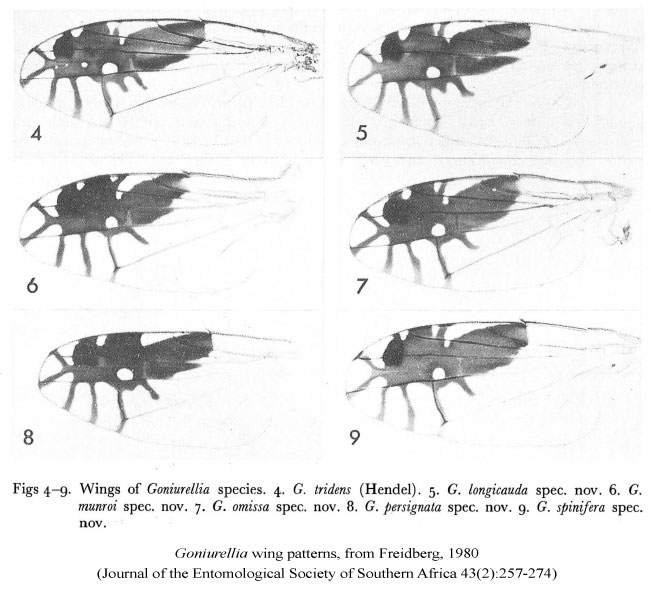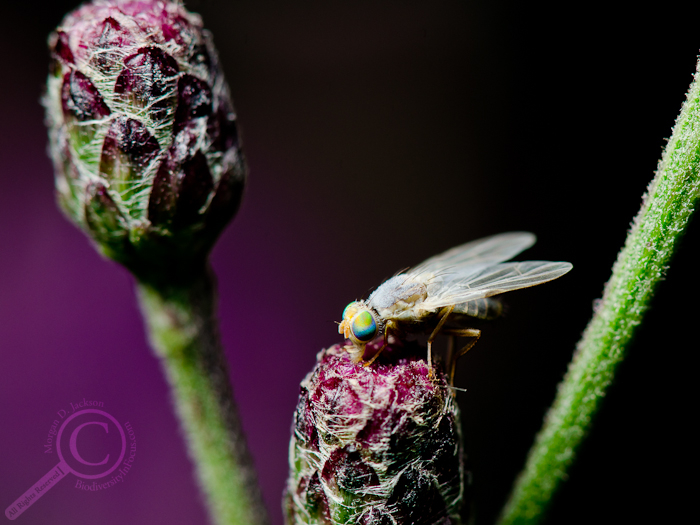There’s a pretty remarkable fly photograph making the rounds of social media today, and while it originally had me going “Oooooh!”, the more I think about it, the more I feel like we’re staring at clouds.
It started when Ziya Tong tweeted a photo of a Goniurellia tridens (a fruit fly in the family Tephritidae) displaying its wings:
Goniurellia tridens is a 3-in-1 insect [photo: Peter Roosenschoon] pic.twitter.com/i8ThAOkrvN
— Ziya Tong (@ziyatong) November 4, 2013
Do the wing patterns look a bit like ants to you? The photo has since been picked up by a number of high profile sites, like the New York Times Dot Earth Blog, Why Evolution is True and It’s Okay To Be Smart because, hey, it looks like this fly brings friends with it where ever it goes. I’m all for flies getting some positive exposure & attention, but the more I look at this fly and think about its relatives & evolutionary history, the more I think we’re all reading too much into that pattern.
This stellate (star-like) wing pattern is very common among flies in the Tephritinae, the subfamily of fruit flies this species belongs to, although the specifics differ between species and genera. Here are the wing patterns of the other Goniurellia species (found across the Mediterranean, Middle East, Africa and Asia).
It’s easy to think that species in far away places like the Middle East and Africa have special, exotic adaptations, but in fact we have equally cool species in our own backyards. If you look closely at some of the species nearby, you can see this general wing pattern is conserved in other tephritine genera, like Trupanea and Euarestoides, just without the darker “eyespot” (technically called a bulla, a dark, blister-like bubble of the wing membrane, which can be found in other local-but-less-ant-like wing patterns, such as Euaresta bella‘s).
Another theory that’s been circulating is that rather than ants, the wing patterns may be representations of jumping spiders. Again, there’s some precedence for this, as several Rhagoletis & Zonosemata species (which are fruit crop pests, and thus more heavily studied) have been shown to hold their wings in such a way as to give them the appearance of an 8-legged threat. But these flies put on a grand charade, using their entire bodies to fool predators into backing down, not just the tips of their wings. Additionally, the spider mimicking flies are in a totally different subfamily, and while the higher relationships of Tephritidae are still being figured out, as far as I can tell no one has ever suggested spider-mimicking wings are an ancestral state shared by both subfamilies, and would therefore argue there’s not a strong evolutionary link. That’s not to say there’s not some form of convergence occurring, but it’s important to note that the ant-winged flies are more closely related to species that look like this
and this
than they are to species that look like this
In all of these examples though, we’re looking at the wings splayed out, and not than in their natural resting position. Take a look at this Trupanea actinobola photo by Steve Marshall showing how the wings look when not in use.
When the two patterns are put together, the “ants” would be standing on top of the other’s feet, which isn’t exactly the most natural behaviour for an ant. It’s possible that the wing patterns together are serving as a false-head (as suggested to me by Richard Jones on Twitter), and thus tricking predators into attacking the wing tips first (which would still be bad for the fly’s ability to fly) or into attacking the false-head from “behind”, thus putting them squarely in front of the true head and easily watched and avoided by the fly. This strikes me as a pretty reasonable argument, but why might there be so much variation in wing patterns if species are using them as a false head?
Another factor to consider is what other uses wing patterns may have besides predator avoidance. Many fruit flies, especially those within the Tephritinae, have very complex mating rituals, and will perform routines that can involve any combination of leg waving, body swelling and wing waving & supinating (plus many other behaviours). Of course, if these wing patterns and flag-waving behaviours are for the female’s benefit, then it would follow that they can actually see and recognize the patterns and routines. While chemical stimuli (both from host plants and aggregating flies) are generally believed to draw individuals from long ranges into close proximity, it seems that fruit flies have very strong visual acuity, and can correctly identify conspecifics based on wing patterning when presented with a choice (Headrick & Goeden, 1994). This means that small changes in wing pattern can help diverging populations sort themselves out, even if host plants and other factors remain the same.
Returning to the viral ant-winged photo, it would appear that the fly is supinating its wings (twisting the wing 90o and pressing forwards to display patterns), which can occur both when a species is pretending they’re a threatening spider as well as in species with courtship wing displays, which doesn’t help us decide what’s going on — is there a female just off camera that’s being courted, or is the fly threatened by the giant camera lens in its face? However, if you look closely at the photo you can see that the middle and hind legs are actually curled up under the body and the fore legs are not resting in a natural position at all — they look more like a ballerina en pointe, with the last leg segments curled and with the tops of the “feet” (the tarsomeres) resting on the surface of the substrate — which leads me to believe the fly in the photo may be dead, or at least heavily compromised, and not actively displaying its wings at all!
Putting everything together, it leads me to believe we may be choosing to see ants where they don’t actually exist. Much like how we see sharks in the clouds or Jesus in our toast (a psychological phenomenon called Pareidolia), I think we’ve become so conditioned to expect ornate patterns on wings to be mimicking something else that we’re forcing objects to appear everywhere, even if there’s no evolutionary or behavioural explanation for it. It’s important that we don’t let our human-centric points of view, emotions and opinions bias our interpretation of what’s really going on. The fact that there are so many amazing and believable mimicry strategies in the world of insects is awe-inspiring, but rather than trying to fit them all in to the same box, we should instead be working to understand what crazy new idea natural selection is experimenting with now.
—-
Freidberg A. (1980). A revision of the genus Goniurellia Hendel (Diptera: Tephritidae), Journal of the Entomological Society of Southern Africa, 43 (2) 257-274.
Headrick D.H. & Goeden R.D. (1994). Reproductive behavior of California fruit flies and the classification and evolution of Tephritidae (Diptera) mating systems, Studia Dipterologica, 1 (2) 194-252.
Fruit fly wing photos and Trupanea actinobola live habitus from:
Jackson M.D., Marshall S.A., Hanner R. & Norrbom A.L. (2011). The Fruit Flies (Tephritidae) of Ontario, Canadian Journal of Arthropod Identification, 15 1-251. DOI: doi:10.3752/cjai.2011.15









[…] Biodiversity in Focus […]
[…] […]
[…] You ever read a really cool science story in the news that sounds so awesome that it’s hard to believe? The latest one is about a fly with scary-looking critters patterned on its wings – believable but awesome. All kinds of people got duped but Morgan Jackson knows enough about flies that he looked at the same set of facts, got the story right, and then retold the story with high class. […]
[…] Ant patterns on fly wings? (via Morgan Jackson) […]
[…] photo of a fly with what look like ants on its wings has gone viral. Morgan Jackson is not […]
[…] http://whyevolutionistrue.wordpress.com/2013/11/05/fly-with-ant-mimic-wings Biodiversity in Focus: http://www.biodiversityinfocus.com/blog/2013/11/06/ants-spiders-or-wishful-thinking/comment-page-1/#… Reptil Centre: […]
[…] a pretty remarkable fly photograph making the rounds of social media today, and while it originally had me going “Oooooh!”, the […]
[…] of loveliness. Might we sometimes see mimicry for more than what it may be? Superb analysis by Morgan […]
[…] […]
[…] devemos ter cuidado ao tirarmos conclusões como essas e evitarmos o fenômeno da pareidolia (percepção de imagens ou sons vagos como algo com sentido). Quando essa mosca está parada, a […]
[…] e aprimorado pela seleção. Essa é a opinião de alguns entomologistas, como pode ser visto neste post (do qual retirarei algumas imagens). Aliás, o primeiro parágrafo desse post resume quase que […]
[…] self-deception, is a selective adaptation (one assumes therefore genetic rather than learned). (Click here for an interesting discussion of apparent mimicry in a fruit […]
[…] ist über dieses Bild auf Twitter gestoßen und hat recherchiert was man hier sehen könnte. Wir mahnen vor zu schnellen Deutungen und lernen warum Pareidolie uns Gesichter auf dem Mars und Jesus auf […]
[…] specimen collected in 1985 by Amnon Friedberg (who happens to be the same guy who studied and described several of the “ant-winged” fruit flies that went viral earlier this month — the dipterological community is an incestuous little […]
[…] The video of this picture wing fly was recorded on April 24th 2011 in Athens, GA. It has a curious wing pattern which resembles a jumping spider but is it really? […]
[…] Skeptical take on those flies with ‘ants’ on their wings. /via @stevesilberman /KF […]
[…] in several moth genera, and in other insects as well. Some will debate whether this apparent image actually evolved to depict what we want it to be, but I can only imagine the reaction of a jumping spider to this image and behavior by the moth. […]